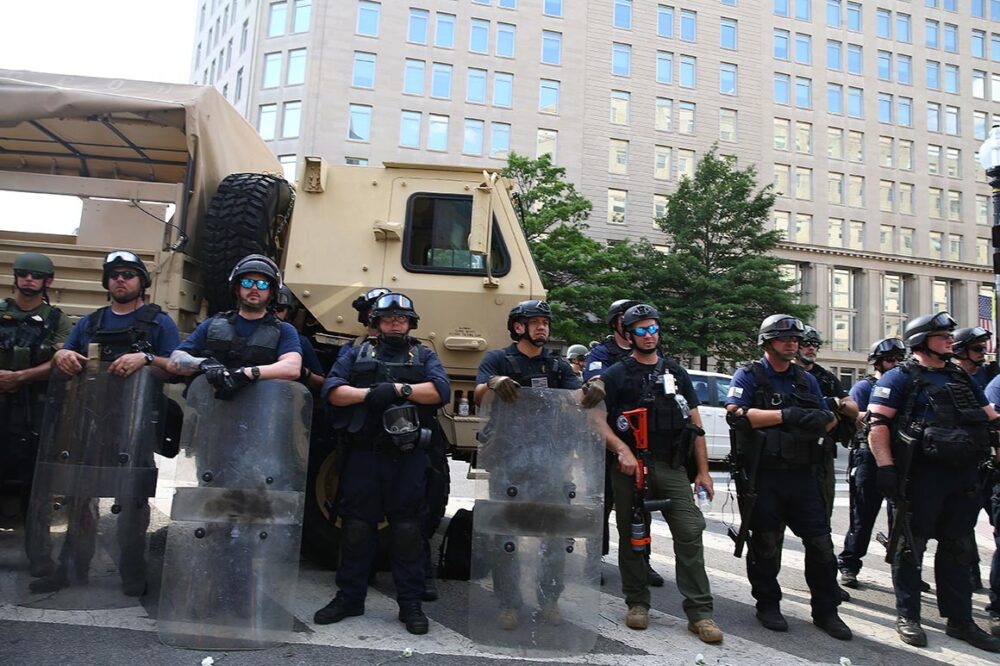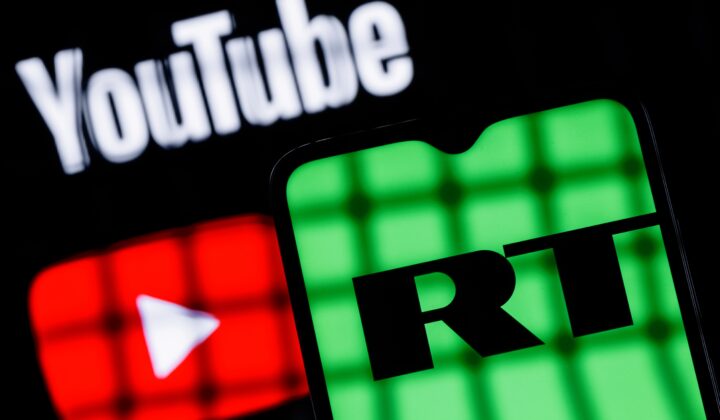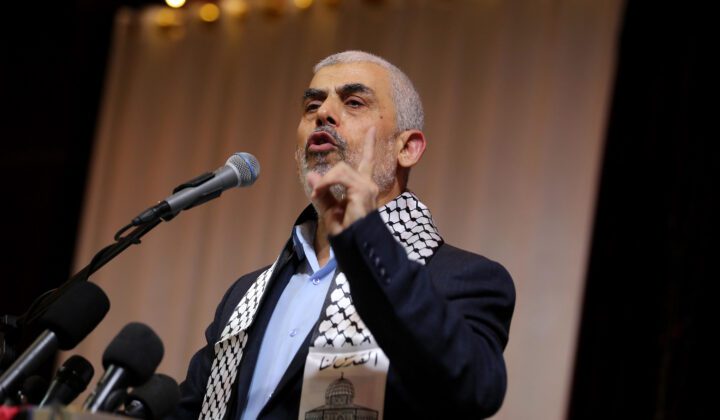Unidentifiable Federal Agents Emerge in the Capital
As nationwide protests against systemic racism and police brutality continue, we have seen a new and unsettling development. Last week, unmarked federal officials surged into the US Capital wielding assault rifles and riot gear, refusing to disclose their affiliations. This followed the Trump Administration’s vow to use “domination” as a strategy to dispel civil unrest. Images of these units (here, here, and here) circulated on social media and prompted many to question who had ordered these individuals to remove insignias and name plates from their clothing.
In a press conference last Thursday, Attorney General William Barr expressed support for the increased police presence and revealed that the Department of Justice had enlisted the Special Operations Response Team (SORT) of the Federal Bureau of Prisons to manage the demonstrations. The presence of wholly unidentifiable SORT units angered protestors and led prominent lawmakers to call upon the Trump Administration to provide a list of all federal agencies involved in the policing effort. Citing the absence of a law on identification requirements, Senator Chris Murphy and Senate Minority Leader Chuck Schumer have announced legislation to require federal officers responding to protests to clearly mark their name and agency on their uniform.
- Why must the police identify themselves?
In a democracy, the state must be accountable to the people, especially in cases where it uses force. At a time when the American public is protesting systemic abuses of power by law enforcement nationwide and is witnessing acts of police violence, the presence of unidentifiable federal agents clearly illustrates an absence of accountability. It is impossible to hold state actors responsible for potentially illegal conduct when you don’t know who they are or who they work for. Many instances of police using excessive force since George Floyd’s murder have been exposed only because bystanders with smartphones have been able to accurately identify officers caught in the act. America has a transparency problem amongst law enforcement, and the presence of unidentified, armed federal agents only exacerbates this problem. While thus far, these unidentifiable SORT units have only appeared in the capital, reports that local police have started to cover their badge numbers further complicate efforts to reform the policing system in our country.
- How else can anonymous law enforcement undermine our democracy?
Although these unidentified officers are certainly employed by the government, what is stopping far-right extremist groups cosplaying as paramilitaries from operating under the cover of anonymity in their own cities and towns nationwide? And what is stopping a presidential administration from employing unmarked militias to act as a paramilitary army? The point is, it is impossible to ensure that armed people with unclear training and no identification are actually loyal to the Constitution rather than something else entirely. As the President makes clear his intention to use violence to dispel protests, it is imperative that the American people know that law enforcement answers to the people. Historically, secret police and paramilitaries from Argentine death squads to Russia’s Little Green Men have used anonymity as a tool to subvert the rule of law. When citizens don’t know who the police are, who is in charge, or what their mission is, it is easier for corrupt politicians to use these forces to influence elections, intimidate opponents, and abuse the state’s monopoly on violence.

The New York Times Opinion Section in Turmoil
James Bennet, the editorial page editor of The New York Times, resigned from his position following a massive backlash to the publication of Senator Tom Cotton’s op-ed on using the insurrection act to send troops into American cities. The piece argued that the military should impose order through “an overwhelming show of force to disperse, detain and ultimately deter lawbreakers.”
The editorial page had initially solicited the op-ed from Cotton after the Senator had expressed support for deploying active-duty military forces, saying among other things on Twitter: “No quarter for insurrectionists, anarchists, rioters, and looters.” Once published, however, numerous staffers and writers for The Times, internally and publicly, aired their deep disagreement with the publication. They argued that it was promoting violence against protestors and creating a dangerous environment for reporting, especially for Black reporters. An editor’s note was soon added to Sen. Cotton’s piece and the piece did not appear in the Sunday edition. Before resigning, Bennet admitted that he had not read the Op-Ed before publication. The publisher of The New York Times, Arthur Sulzberger Jr., stated: “Both of us concluded that James would not be able to lead the team through the next leg of change that is required.”
- What does this say about the state of journalism today?
First, The New York Times and other mainstream publications have felt pressure to present these sorts of extreme viewpoints in their opinion pages in order to maintain some semblance of objectivity. Aside from factual issues, Cotton’s op-ed promoted troubling ideas—notably, the widespread deployment of US troops in American cities—that if effectuated could seriously undermine our democracy. Meanwhile, right-wing outlets like Breitbart and Fox have continued to pollute the marketplace of ideas with outright lies and propaganda with questionable adherence to journalistic norms or objectivity.
Second, the manner in which Bennet was publicly excoriated by his colleagues and lost his job recalls the worst aspects of call-out culture. There were editorial failings in the publication of the piece, which may have been fireable offenses, but the incident sets a worrying precedent for the management of America’s most trusted newspaper. Bennet had successfully supervised the opinion section for four years, bringing on diverse intellectual voices, ranging from RDI Advisory Board Member, Bret Stephens, to Jamelle Bouie. His replacement, Katie Kingsbury, told staff, “Anyone who sees any piece of Opinion journalism, headlines, social posts, photos—you name it—that gives you the slightest pause, please call or text me immediately.” This type of exhortation should give all of us who value a competitive marketplace of diverse and sometimes controversial ideas pause.
- Should the NYT have run the op-ed?
Given Tom Cotton’s public stature and his ability to act upon his ideas as a member of the Senate, one might argue that it is in the public interest to publish his opinion so that readers are informed. According to this view, it’s imperative not to confuse the publication of an idea with an endorsement of it.
On the other hand, perhaps it may have been better to cover Cotton’s statements as a news story instead of granting him such a prominent venue to articulate an opinion that does not accord with democratic norms or rigorous fact-checking. It is deeply worrying that a senator would call for the unilateral deployment of active-duty troops to American cities. To date, 9 governors and former Secretary of Defense Jim Mattis have come out against such deployment.
America Breaks Out in Peaceful Protests
Sparked by the murder of George Floyd, the past week has seen some of the largest peaceful civil rights protests in a generation as hundreds of thousands gathered in cities across the country to demand racial justice and police reform. Small protests even reached places like rural towns in Montana and former Klan towns in the south. In stark contrast to the prior week of violence and rioting that saw curfews descend upon dozens of cities and the arrest of over 10,000 protesters, this week’s protests remained predominantly peaceful.
The protests brought moments of joy and solidarity, highlighted by black faith leaders rallying in the newly renamed Black Lives Matter Square in Washington, DC. They also brought pressure for action and change: all of the officers involved in George Floyd’s death have been charged, the NFL has reconsidered its position on kneeling, and New York lawmakers have banned the NYPD’s use of chokeholds. Experts have noted that these Black Lives Matter protests are larger, more diverse, and more universally supported than ever, and they’re spreading across the globe.
- What do these protests tell us about our democracy?
Americans across the country are coming together in unison for racial justice. Public figures of all political persuasions—from Mitt Romney and George W Bush to Elizabeth Warren and Kamala Harris—have spoken or marched in support of the movement. Military leaders from James Mattis to Colin Powell have decried the President’s threat to use the military against protesters. In short, these protests are proving that Americans of all ages, races, and political backgrounds can unite around our shared democratic ideals.
Massive, peaceful protests against corrupt or unresponsive governments, like those that occurred last year in Puerto Rico and Algeria, are models of enacting democratic cultural and legal changes from the bottom up. In regimes with the trappings of liberal democracy, they can force governments to live up their own constitutional standards. The current protests are proving once again, like their forerunners in the Civil Rights Movement, that protest movements can effect real change.
- Is it safe or advisable to protest during a pandemic?
This is incredibly hard to answer. The imperative to hold these historic civil rights protests seems directly at odds with the imperative to protect our fellow citizens from the pandemic. However, citing the disproportionate deaths of black people during the pandemic and generally poor access to health care, many protesters have argued that combating systemic racism now will ultimately save more lives later, claims that have been supported by some public health officials. Unfortunately, however, this cost-benefit analysis is speculative at best.One expert wrote that each day of protests will result in over 3,000 new infections per day. But experts also note that it’s hard to solely blame protestors for increasing infections; restaurants and other public spaces were reopening just as protests began, and police have faced harsh criticism for not wearing masks as they exercise force. Nevertheless, though this is difficult to accomplish, it is possible to minimize the risk by maintaining proper social distance and wearing masks.

UK Offers Visa Hope to Hong Kong Citizens
In response to the national security laws China is planning to impose on Hong Kong, Boris Johnson, the British Prime Minister, has said that the UK will offer 3 million visas to Hong Kong citizens seeking to flee China’s encroaching authoritarianism. These individuals will be made eligible to eventually gain the right to work in the UK for a renewable period of 12 months and start a path toward citizenship. Chinese state media has responded aggressively to Boris Johnson’s announcement, warning that China could cancel a proposed free trade agreement between the countries and cause ‘substantial damage’ to Britain’s economy.
- Why is Britain taking this step to protect democracy?
Britain’s quick response is driven by the commitments it laid out to Hong Kong under the 1997 agreement that transferred the region from British to Chinese control. In addition to the region being granted its own legal system and exclusive individual freedoms, such as free speech, the UK also pledged an enduring commitment to Hong Kong’s prosperity. As Hong Kong faces new security laws violating the terms of “One Country, Two Systems,” Britain is being called upon to honor this commitment. Despite China’s threats of economic action against the UK, Dominic Raab, the UK’s Foreign Secretary, has stated that protecting the people of Hong Kong is “a matter of principle”, and Boris Johnson wrote in a Hong Kong newspaper that “Britain could not in good conscience shrug our shoulders and walk away.”
- Is there a precedent for this move?
While this situation is largely unique, it has some similarities to the 2015 European Migrant Crisis, wherein millions of refugees from the Middle East and North Africa were forced to flee dangerous political situations and attempted to seek asylum in Europe. Germany alone received over 476,000 asylum applications, eventually granting most of the applicants work visas and a path to citizenship. Yet the refugee crisis had to ultimately be solved by establishing a Europe-wide quota system for incoming refugees, meaning that most countries in the EU were legally bound to accommodate a certain number of refugees. A similar system would likely have to be in place to accommodate Hong Kong’s fleeing citizens. Britain has already reached out to the US, New Zealand, Australia and Canada in a plan to form a global alliance and split up the number of Hong Kong citizens that each country takes. While America was once a world leader in refugee resettlement, more recently, it has begun to trail behind its Western counterparts. It is important that America’s leadership remember that those who flee tyranny to be here often become citizens who value our liberties with a fervor those of us raised in freedom may not appreciate.





